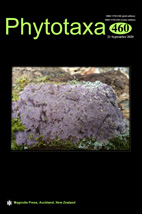Abstract
A new species from the genus Placoneis (Bacillariophyceae: Cymbellales) is described on the basis molecular and morphological data. Placoneis cattiensis Glushchenko, Kezlya, Kulikovskiy & Kociolek sp. nov. is described from soil collected from the bottom of a dry, temporary stream in the forest of Сát Tiên National Park in Vietnam. On the basis of molecular data our new species appears to be more closely related to two strains of Placoneis previously identified as P. elginensis. However, P. cattiensis shows lower statistical support with two strains of P. elginensis on the basis ML. Additionally, P. cattiensis is distinguished from P. elginensis on the basis of morphological features such as the shape of the valve, breadth and density of areolae and striae. Comparisons of P. cattiensis with other similar species are given.

